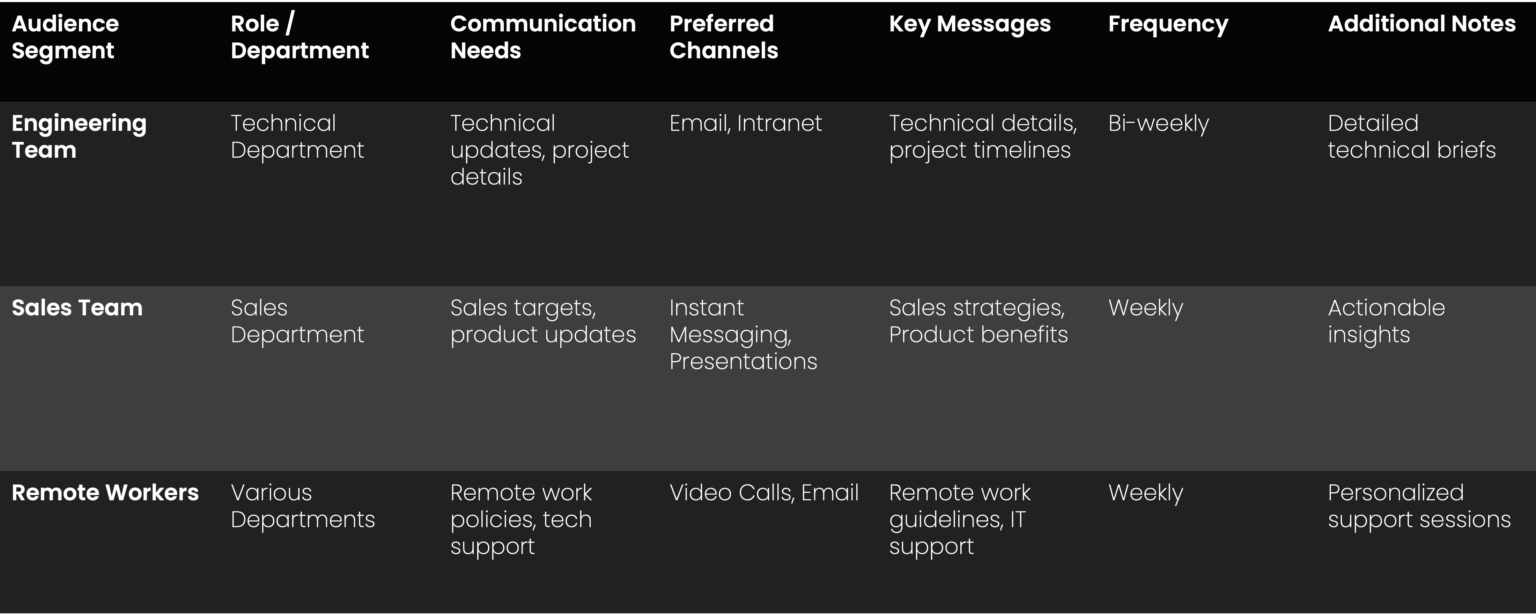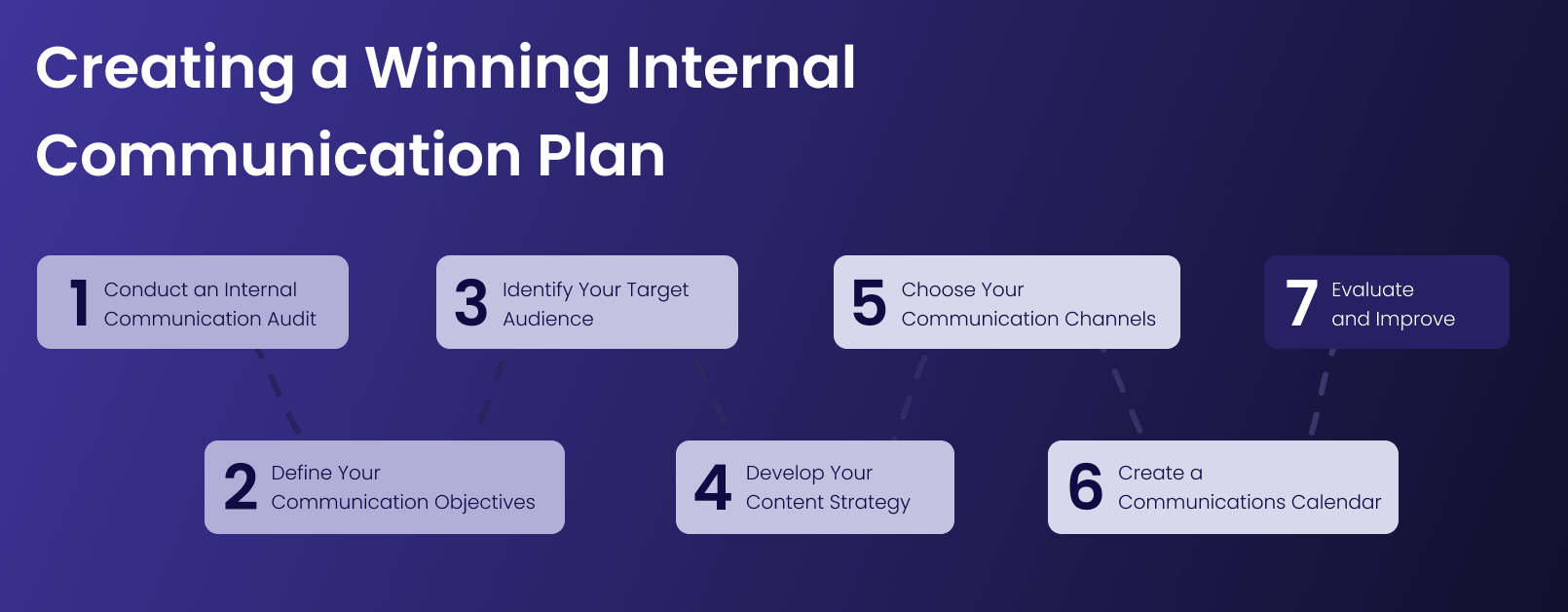Creating a Winning Internal Communication Plan
Business communication can only become a driving force with a well-structured plan. In this article, we’ll provide you with the necessary strategies.
Table of Contents
It’s impossible not to communicate. Talking, silence, gestures, facial expressions. Even our absence can be read as an act of communication.
So everything we do (and don’t do) is communication. But what is the right way? And how do I make sure it works in the company?
The solution is a well-thought-out internal communication plan.
In this article, we’ll tell you what exactly internal communication is and what strategies you can use to create the perfect internal communication plan.
Here we go.
What exactly is internal communication?
Before diving into crafting a strategic plan for internal communication, let’s take a moment to understand what internal communication entails and why nailing down a solid strategy is key to your company’s success.
Internal communication involves sharing information and ideas within an organization through various channels and platforms, connecting employees across different levels. This interaction can occur through official channels or casual conversations by the water cooler.
The main aim of internal communication is to make sure that everyone in the organization is in the loop, engaged, and on the same page with the company’s mission and goals.
Types of Internal Communication
Overall, you can categorize internal communication into different types based on their purpose (informational, cultural, transactional) or by their direction. The latter classification of communication might be more familiar to most people.
For example, we have:
-
Top-Down Communication: Information flows from management to employees, e.g. announcements, directives, and policy changes.
-
Bottom-Up Communication: Employees provide feedback to management.
-
Horizontal Communication: Peer-to-peer communication across departments or teams.
-
Formal Communication: Structured communication channels such as meetings, reports, and official emails.
-
Informal Communication: Unofficial interactions which can significantly impact the company culture.
What is an Internal Communications Plan?
An internal communications plan is your strategic roadmap that outlines how you’ll communicate with your employees. It details the key messages, the channels you’ll use, the timing of communications, and the methods for measuring effectiveness.
This internal communication plan is essential for ensuring that everyone in your organization is informed, engaged, and aligned with your goals.
Why Bother with an Internal Communication Plan?
You might be wondering why you need a formal internal communication plan. We had it at the beginning, it’s impossible to not communicate, so why not let it happen naturally?
When we consider the many types and methods of communication, it’s especially important for larger companies, or those looking to scale, to have a well-thought-out communication plan in place. For instance, when new HR employees are hired, onboarding can be much smoother and more efficient if there is a clear understanding of what needs to be communicated. Additionally, it’s crucial to know how it should be communicated and the appropriate tone to use within the company.
Additional benefits of a strategic internal communications plan include:
-
Alignment and Focus: A plan keeps everyone moving in the same direction. It ensures that communication efforts support overall business goals.
-
Efficiency: Streamlining communication saves time and resources by avoiding redundancies and miscommunications.
-
Employee Engagement: A strong internal communication plan keeps employees informed, connected, and motivated.
-
Crisis Management: In times of change or crisis, a clear communication plan helps manage information flow and maintain employee trust.
-
Reputation Management: Consistent and positive messaging shapes your company’s internal and external reputation.
As you’ve seen now: an internal communication plan is an investment in your company’s success. It helps you build a strong, engaged workforce and achieve your business objectives.
Challenges of Internal Communications
A look at everyday problems in corporate communication helps us appreciate a well-structured internal communication plan. In our article on communication barriers in the workplace, we mention issues like language barriers, cultural differences, and outdated technology.
Information overload is also a common problem. Good intentions don’t always lead to good outcomes. If you constantly update your company intranet with news to keep employees informed, it might be overwhelming.
That’s why we take a strategic approach!
7 Easy Steps to Create an Internal Communication Plan
Here are seven steps to guide you through the process:
Step 1: Conduct an Internal Communication Audit
Before creating your plan, evaluate your current communication practices to identify strengths, weaknesses, and areas for improvement. This can be done through surveys, focus groups, and analyzing communication metrics (e.g., email open rates, intranet engagement).
Questions to Consider:
-
How do employees currently receive information?
-
What communication channels are most effective?
-
Where are the gaps or redundancies in communication?
Step 2: Define Your Communication Objectives
Set clear, measurable goals for your internal communication strategy. Consider using the SMART framework.
SMART is an acronym that stands for:
-
Specific: Clearly defined and focused.
-
Measurable: Quantifiable with specific metrics.
-
Achievable: Realistic and attainable within given resources.
-
Relevant: Aligned with overall goals and objectives.
-
Time-bound: Set with a specific deadline.
Example Objectives
-
Non-SMART goal
-
Improve employee communication.
-
-
SMART goal:
-
Increase employee engagement scores by 20% over the next year.
-
Ensure 95% of employees read the monthly newsletter.
-
Improve response rates to internal surveys by 30%.
-

Step 3: Identify Your Target Audience
Segmenting your internal audience is crucial to delivering the right messages to the right people. Different departments and roles within your organization will have unique communication needs and preferences.
Think about your company’s various departments. For instance, the communication needs of your engineering team might differ from those of your sales team. Engineers may prefer detailed, technical updates via email, while the sales team might benefit from dynamic presentations and quick updates through instant messaging apps.
Considerations:
-
What are the communication needs of different departments?
-
How do communication preferences vary among employees?
-
Who needs to be informed about what, and when?
Here’s a sample layout for identifying your company’s target audience:

You’re probably familiar with the situation: Sitting in a management meeting, spending hours debating whether a piece of information is ready to be shared, who should deliver the news, and where it should be communicated.
To save yourself from these heated meetings in the future, you should establish a clear content strategy for internal communication. You can easily structure this strategy by following the 5 Ws and an H:
-
Why: Starting with why is alwys key. So: Why is this decision being made at all? Why now? Why should your employees care?
-
What: What’s exactly going on? What’s in it for the employees? (Reminder: Being honest always pays off)
-
When: Happened yesterday, happening now or in two years? Communicate the concrete timelines.
-
Where: Where will this decision have an impact? Important for all employees, including remote workers? Or just for some department? And where to find further information on that topic?
-
How: How was the decision made? How will it be implemented? How will it impact employees?
-
Who: Who made the decision? Who’s in charge? Who can employees approach if they have questions?

Further communication tips:
Get to the point: When you publish a news item, you don’t have to start with Adam and Eve and tell how you all got together in the meeting room at C-level and what the mood was like when you made the decision in question.
Be honest: Transparency and honesty are key in boosting employee engagement. When things aren’t going as planned, sharing the facts and a clear solution strategy is more effective than trying to sweep the problem under the rug—after all, bad news has a way of making its rounds among coworkers. It’s always best to take the lead and be the one to communicate the news.
Use clear and simple language: Technical jargon can demonstrate expertise within certain circles, but using it with people who aren’t familiar with it can create confusion rather than clarity. It’s important to tailor your language to your audience to ensure everyone understands the message, showcasing not just your knowledge, but your communication skills as well.
Include a call to action: Encourage employees to engage with the content. Whether it’s providing feedback, attending a meeting, or simply acknowledging the information, a clear call to action can boost interaction.
Follow up: After sending out a communication, follow up to ensure the message was received and understood. This could be through a quick survey or a brief discussion in team meetings. It helps to reinforce important points and addresses any questions or concerns.
Start with a hook: “In today’s fast-paced world …” – might not be the best hook, since everyone knows it’s written by ChatGPT. Instead, think for yourself how you can really get – and keep – the attention of your audience. After all, we’re constantly bombarded with so much information that we tend to concentrate only on topics of real importance and/or emotion.
Step 5: Choose Your Communication Channels
Imagine a scenario where a parcel carrier rings your doorbell and hands you a lovely bouquet of flowers. Tucked inside the bouquet is a letter. Surprise! It turns out to be a letter of termination from your landlord.
This might seem like an extreme situation, but it highlights the significance of choosing the right communication channel. It’s not just about what we say, but also how we say it. The message should always align with the communication platform and the intended audience.
Here are some options and their best uses:
Best For: Formal and detailed communication.
Use When: You need to convey comprehensive information, send official documents, or provide updates that employees can reference later.
Tips: Keep your emails concise but thorough. Use bullet points and headers to make the content easier to read. Ensure the subject line is clear and indicative of the content.
Intranet
Best For: Company-wide announcements and resources.
Use When: You want to share information that should be easily accessible to all employees, such as policy updates, company news, and important resources.
Tips: Keep the company intranet organized and user-friendly. Find out why social intranets still matter nowadays and how they can supercharge your workforce.
Meetings
Best For: Interactive and immediate feedback.
Use When: You need to discuss complex issues, brainstorm ideas, or provide a platform for employees to ask questions and provide input.
Tips: Prepare an agenda to keep the meeting focused. Encourage participation and ensure everyone has a chance to speak.

Other communication channels like Social Media, printed materials or instant messaging might not fit to every company.
To make the best choice, consider the following questions:
-
What is the nature of the message? Formal or informal?
-
Who needs to receive this message?
-
What are their communication preferences?
-
Are they working remotely or on-site?
-
What is the main goal of this communication?
-
Do I need feedback or interaction from the recipients?
-
What tools and platforms do we have available?
-
Do employees know how to use these tools effectively?
-
Is this a one-time communication or part of a regular update?
A perfect communication channel for most companies is the knoledge sharing platform Confluence. Spiced up with the social intranet solution Mantra, you have everything you need for any kind of communication method united in one single source of truth.

Step 6: Create a Communications Calendar
The bigger the company, the more crucial it becomes to have a communication plan in place. Whether it’s about sharing updates on illnesses, vacations, or new team members, it’s key for everyone handling communication to know when and how to share information. Having a clear internal communication strategy helps keep everyone on the same page.

Here is a template for a communications Calendar:

This communication calendar is of course just an example. Feel free to customize the template so that it meets your individual needs. Remember, in internal communication, it’s key to share updates when they’re relevant and not too far in advance. Having a strategic plan in place can also help avoid overwhelming everyone with too much info.
Step 7: Evaluate and Improve
Creating an internal communication plan is not a one-time task. It requires continuous evaluation and improvement to ensure that your strategies remain effective and relevant. To do so, you need to define and list how you will measure progress.
Key Metrics to Track:
-
Email open and click-through rates
-
Intranet engagement (e.g., page views, comments, likes)
-
Attendance at meetings and town halls
-
Feedback and participation rates in surveys
-
Social media engagement
A continuous improvement circle for an internal communications strategy could look like this:
-
Collect Feedback: Conduct a quarterly survey to gather employee opinions on current communication methods.
-
Analyze Metrics: Review the email open rates and intranet engagement stats.
-
Identify Improvements: Notice that employees prefer video updates over lengthy emails.
-
Implement Changes
-
Monitor Progress

Creating a well-structured internal communication plan is an essential step in ensuring that your organization communicates effectively. Remember, it’s impossible not to communicate, so make sure your communication is intentional, clear, and aligned with your business goals. By following these seven steps, you can develop a robust plan that keeps your employees informed, engaged, and motivated.

The Right Communication Makes a Difference
Not communicating is impossible. Communicating really well is super easy with our internal communication plan.
What can be a real game changer here are the right communication channels.
Leveraging tools like Confluence and Mantra can streamline this process, making it easier to keep everyone informed, aligned, and motivated, ultimately driving your company’s success.
Ready to unlock the power of unified communication? Explore Mantra today and experience the difference a well-equipped communication strategy can make!
Supercharge your Confluence
Let’s create something extraordinary together
Schedule a free consultation with our team and let’s make things happen!
Book a demo

Jiliwinbet7login is where its at, yo. Easy to sign up, and I was playing in no time. Good vibes all around, ya feel me? Give it a shot, why not? jiliwinbet7login
U888U888COOL on .com, huh? Had some fun times there. Fair play and a smooth interface. Worth a peek. u888u888cool